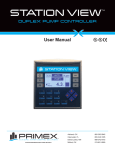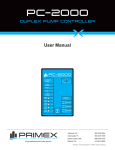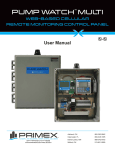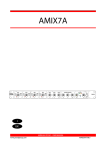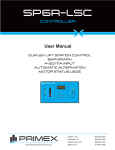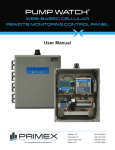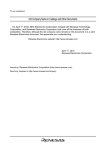Download Manual
Transcript
PC-3000 PUMP CONTROLLER User Manual WWW.PRIMEXCONTROLS.COM Ashland, OH 800-363-5842 Clearwater, FL 800-349-1905 Detroit Lakes, MN 888-342-5753 Milford, OH 513-831-9959 PN 1038551A © 2013 SJE-Rhombus® Rev 09/13 PRIMEX is a trademark of SJE-Rhombus® PC3000 Table of Contents 1.0 INTRODUCTION ............................................................................................. .............. 3 2.0 OPERATION 4 ............................................................................................................... 3 2.1 PUMP DOWN OPERATION............................................... .......... ....................... 3 2.1.1 SINGLE FLOAT BACKUP ................................................... .......... ....................4 2.1.2 PUMP SEQUENCE TIMERS .................................................................... ........ 4 2.1.3 TIME AT SETPOINT .......................................................................................... 4 2.1.4 FAIL TO START TEST ....................................................................................... 5 2.2 PUMP UP OPERATION .............................................................................. ......... 5 2.3 ALTERNATION ......................................................................................... ............ 5 2.4 STARTUP ................................................................................................ ............. 6 2.5 FRONT PANEL INDICATORS AND CONTROLS ............................................. ... 6 2.6 SETPOINT MENU ................................................................................................ 8 2.7 CONFIGURATION MENU .................................................................................... 8 3.0 SPECIFICATIONS ................................................................................. ............... .......11 3.1 INPUT SIGNALS ................................................................................. ........... ....11 3.2 OUTPUT SIGNALS ................................................................................. .......... .12 4.0 CONNECTOR PINS ..................................................................................... ............. ..13 FIGURE 1 FRONT VIEW ..................................................................................... ............ .15 FIGURE 2 BACK VIEW ............................................................................. ............. ...........16 FIGURE 3 MOUNTING DIMENSIONS ................................................................ ..............17 FIGURE 4 EXAMPLE WIRING ............................................................................. .............18 QUICK SET UP CHART ................................................................. ........ .............APPENDIX PRIMEX™ 2 PC-3000 Specifications PC3000 1.0 INTRODUCTION The PC-3000 is a general purpose pump controller designed to control up to 3 pumps, in either pump up or pump down applications. It sequences pumps on and off in response to changes in level, pressure, or flow. The primary sensor input is a 4 to 20 mA. current loop which can be connected to any sensor which has a 4-20 mA. output. When used to control level in a tank or well the input is usually connected to a pressure transducer, or ultrasonic transmitter. A loop power supply is provided in the PC-3000. The PC-3000 can be configured for many applications using it’s easy-to-use front panel user interface. Wiring is easy using removable terminal blocks on the back cover. Field replacement is easy because the terminal blocks unplug from the controller so no wires need to be disconnected. FEATURES • 32 character alpha-numeric liquid crystal display for level, status, and setpoint information. • Alternation selection switch on front panel to turn alternation on and select the lead pump if alternation is off. • Simple menu structure for easy display and modification of setpoints and setup configuration. • Built in elapsed time meters for all pumps. They are nonvolatile and easily examined from the front panel. • 4 to 20 mA main sensor input with loop power supply for easy connection to most transducers and transmitters. Adjustments are provided for both scale and offset. • Inputs for pump seal leak sensors and pump over temperature sensors with display messages for out of specification conditions. • Fully scaleable 4-20 mA level output transmitter. • Built in single float backup system for pump down applications. • Three auxiliary inputs which can be pump disable or pump run confirmation inputs for a fail to start test. • Built in horn relay with internal and input for external mute button. • Relay outputs for both high and low level alarms with adjustable setpoints. • Individually selectable on and off setpoints for up to three pumps. • All inputs are filtered and transient protected. • Built in software, no programming required. • All inputs operate on low voltage and current. • Input power is 115 V AC, internally fused and transient protected. • All terminal strips unplug without removing the wires for easy field replacement. 2.0 OPERATION 2.1 Pump Down Operation Pump down is used in applications , like wastewater lift stations, where a liquid flows into a tank or well and must be pumped out. As liquid flows in the level in the well rises. The level is continually monitored by the level transmitter which sends a 4-20 mA signal to the controller which displays the level on the first line of the display. If the level is below the low alarm setpoint then the low alarm light and relay are activated. If the horn is enabled then it too will be activated. As the level rises above the low alarm setpoint the low alarm condition will be cleared. When the level rises above the lead pump on. PRIMEX™ 3 PC-3000 Specifications setpoint the lead pump will be called to run. Which pump is the lead pump is determined by the alternator. The current lead pump is displayed on the right side of the top line of the display. When the lead pump starts the liquid level should begin to fall as liquid is pumped out of the well. When the level falls to the lead pump off setpoint then the lead pump will be stopped and the alternator sequenced if it is on. If the level continues to rise it will reach the lag pump on setpoint and the lag pump will be called. If the level then falls to the lag pump off setpoint then the lag pump will be turned off. The lag pump will not be called if the total number of pumps setting is 1. If the lead and lag pump running do not cause the level to fall then the third pump will be called when the level reaches the lag2 on setpoint and if three pumps are selected for the maximum number of pumps. If the level continues to rise then it will reach the high alarm setpoint and set a high alarm condition. The high alarm light and relay will be activated. If the horn is enabled then it too will be activated until the alarm condition clears or until the mute button is depressed. 2.1.1 Single Float Backup A single float backup system is provided in pump down mode only. It can be useful if the primary level sensor fails. A single normally open float switch is connected to the float input and suspended in the well at a point above the normal operating levels of the system. In this way the float will only be submerged if level rises above that required to call on all available pumps. The backup system is enabled by setting a backup time ( in seconds ) in the backup time setpoint of the configuration menu. If this time is zero then the backup system is disabled. If the high float is activated, and backup is enabled, and the controller is not already calling for all available pumps then the backup mode is initiated. The float light on the front panel is turned on and the lead pump is called to run. At the same time two timers are started, one for 30 sec. and one for 60 sec. If the high float opens ( comes out of the liquid ) then these two timers are cleared and no further pumps will be called. The lead pump will remain on for the period of time set in the backup time setpoint. If the 30 second timer expires before the high float opens then the lag pump will be called if there are at least 2 pumps. If the 60 second timer expires before the high float opens then the second lag pump will be called if there are three pumps. All pumps will be sequentially turned off after the high float has been open for a period of time equal to the backup timer setpoint. The float light on the front panel will remain on until cleared by the reset/mute button on the panel or the external reset/ mute button. 2.1.2 Pump Sequence Timers In both pump up and pump down modes there are two timers which prevent more than one pump from turning on or off at the same time. These timers prevent excess power loads when pumps are turning on and some hydraulic problems ( water hammer ) when pumps are being turned off. 2.1.3 Time At Setpoint The PC-3000 has a feature which prevents any pumps from being turned on or off until a setpoint condition has been satisfied for a minimum time. This minimum time is the TIME AT SP setting in the setup menu and can be set from 0 to 31 seconds. As an example, assume this setting is set for 8 seconds, and we have a pump down system (lift station). Then, the water level in the tank must exceed the lead on setpoint continuously for 8 second before the lead pump will be called. There is not much need for this in most lift stations as the level changes slowly but this feature can be very PRIMEX™ 4 PC-3000 Specifications useful in water pressure (pump up) systems where the pressure may swing wildly for several seconds after a pump is turned off or on. If this time is set longer than the pressure takes to settle then no further pump calls will happen until the new pressure has stabilized. 2.1.4 Fail to Start Test The PC-3000 has an optional fail to start test. This optional test is controlled by the START TEST time in the setup menu. If this time is zero then this test is disabled. If the start test is enabled then the AUX/DIS inputs for each pump must be connected through a dry contact to ground. These contacts must close and short the AUX/DIS input to ground when the pump is running. The auxiliary contact on the starter or a switch on the check valve arm can be used. If the start test is disabled ( time=0 ) then these inputs are pump disable inputs. For example lets assume that the test is enabled with a START TEST time of 15 seconds. When a pump is called a timer is started for that pump. If the timer reaches 15 seconds and the AUX/DIS input for that pump has not been shorted to ground then a fail to start test failure is set for that pump. The pump is then disabled and the next available pump is called in its place. This failure condition is displayed on the front panel and will remain active until reset by either a reset button or reset input. The high level alarm will also reset this condition. This is to make sure that a broken or misadjusted check valve switch does not cause an overflow. 2.2 Pump Up Operation Pump up mode is used in situations, like water distribution, where the pumps must maintain a pressure or fill a tank ( like a water tower ). For the purposes of this description assume we have three pumps which will be used to maintain the level in a water tank. The level is sensed by pressure transmitter mounted in base of the tank and all three pumps send water to the tank. As water is dispensed from the tank the level drops. If the level drops far enough to reach the lead on setpoint then the lead pump is called to run. This should cause the level to rise until the lead off setpoint is reached and the pump is shut down. If the alternator is on then the lead pump will be sequenced to the next available pump. If the level continues to fall then the lag on setpoint will be reached and the lag pump will be called. As in pump down operation each pump has separate on and off setpoints and there are setpoints for high and low alarm. Unlike pump down the pump up mode does not have a float backup system. 2.3 Alternation The PC-3000 has an automatic alternation system which can be used to cause a different pump to be used each pump cycle. This is useful to equalize pump wear. When the alternator is off the lead pump can be selected and that pump will always be called first. The alternator on the PC-3000 is controlled by a toggle switch on the front panel. When the switch is in the up position the alternator is on and the lead pump will be changed each cycle. When the switch handle is in the center position the alternator is off and the lead pump is selected by pushing the handle down. The handle has a spring return from the down position. Each time the handle is pushed down the lead pump will be incremented to the next available pump. The current lead pump is displayed on the right side of the first line of the display ( LP=2 ). PRIMEX™ 5 PC-3000 Specifications For systems with two pumps, alternation ( if on ) simply swaps lead pump duty between the two pump each pump cycle. If there are three pumps, alternation can be either of two options: In normal alternation, each pump cycle the next available pump is selected as lead so that if all pumps are available then each will be lead every third time. The other option is jockey pump. In this type of system pump 1 is a small pump and pumps 2 and 3 are large. The small pump (pump 1) is always the lead pump and the other two pump alternate as lag and lag2. When either of the two large pumps are on the small one is turned off. This is useful in systems where demand can be low at some times and large at others. 2.4 Startup When the PC-3000 is first powered up it executes an internal self test. During this test many internal functions are checked and the displays are sequenced. The system is controlled by an internal microcomputer which is monitored by a watchdog timer system which will restart the system in the unlikely event that the program fails to execute properly. After the self test is complete several timers are started which prevent any relay outputs from activating until all of the system inputs have had a chance to settle and all of the input filtering has resolved to their proper values. 2.5 Front Panel Indicators and Controls Figure 1 is a view of the front panel of the PC-3000. It includes eight LED lamps, a 32 character LCD display, 5 push buttons, one toggle switch and one adjustment knob. They have the following functions. 1. PUMP 1 THRU PUMP 3 LAMPS These three green LED lamps indicate which pump is currently being called. 2. OFF LAMP This green lamp indicates that no pumps are currently called to run. 3. HIGH LAMP This red lamp signals that the level is above the high setpoint. 4. LOW LAMP This red lamp signals that the level is below the low setpoint. 5. FLOATS LAMP This red lamp will be on if the system has had a float backup cycle since the last reset or power up. 6. XDUCER LAMP This red lamp signals that the main level sensor input is outside of its normal range of 4 to 20 milliamps. This is useful for detecting transducer failures. 7. ALT SWITCH The alternate switch will turn alternation on when up and off when in the center position. When it is pushed down the lead pump will be sequenced to the next available pump. The current lead pump is indicated on the first line of the display. 8. MENU BUTTON This button is depressed and held for 10 seconds to enter the setpoint menu. PRIMEX™ 6 PC-3000 Specifications 9. UP / YES BUTTON This button has several functions depending on the mode of the controller. When the controller is in normal mode (not in one of the menus) this button causes the bottom line of the display to sequence between pump status and the three elapsed time meters. After 15 seconds the bottom line of the display always reverts to pump status in normal mode. When the controller is in one of the two menus this button is used to increment the current parameter being adjusted or to tell the system to save the new value. 10. DN / NO BUTTON This button has several functions depending on the mode of the controller. When the controller is in normal mode (not in one of the menus) this button caused the bottom line of the display to sequence between the pump status and the three elapsed time meters. When the controller is in one of the two menus this button is used to decrement the current parameter being adjusted or to tell the system not to save the new value. 11. MUTE / RESET BUTTON This button will reset any current latched up alarms such as temp fail or backup float. It will also silence the horn if an alarm is currently active. 12. TEST / ADJUST BUTTON AND KNOB The function of these two operators depends on the mode of the controller. When the controller is in the normal ( not menus ) mode these operators are used to test the system. When the TEST button is depressed and held the ADJUST knob will be the level for the system. As you turn the knob up and down the level will go up and down. This will call on pumps and make alarms just as if the level was coming from the transducer. The controller will switch back to the transducer 8 seconds after the button is released. When the controller is in one of the menus these operators are used to change the value of the setpoint or parameter. Depressing and holding the ADJUST button will cause the knob value to be placed in the current parameter or setpoint. This can be used along with the up and down buttons to easily adjust all of the setpoints. 13. 32 CHARACTER DISPLAY This alpha-numeric display has two lines of 16 characters each. The first line always displays the current level in feet and the current lead pump. The second line depends on the mode of the controller. In normal mode this line displays pump status or the elapsed time meters. Pressing the up or down buttons will sequence through the three elapsed time meters. After 15 seconds this line will revert to pump status. When pump status is displayed the display will read ALL PUMPS OK if there are no pump faults. If there are pump faults, such as temperature failures or seal failures, they will be displayed one at a time every 2 seconds. In either of the two menus the second line of the display shows the parameter being adjusted and its current value. PRIMEX™ 7 PC-3000 Specifications 2.6 Setpoint Menu The setpoint menu is used to examine and change the on and off setpoints for the pumps and the high and low alarm setpoints. The menu is entered and updated using the following procedure: 1. Depress the MENU button and hold it until the first setpoint appears on the bottom line of the display. This will take about 10 seconds. 2. The display should say LEAD ON = XX.X FT. where XX.X is the current value for the lead pump on setpoint. 3. If you wish to change this value then use the UP or DOWN buttons or you can hold the ADJUST button down and turn the ADJUST knob until the value is correct. After the value is correct then depress the MENU/NEXT button to go to the next setpoint. 4. If you have changed the value then the displays will ask SAVE? (Y/N) If you wish to save the new value then press UP/YES if not then press DOWN/NO. The display should change to the next setpoint. 5. The display should say LEAD OFF = XX.X FT. where XX.X is the current lead off setpoint. Repeat steps 3 and 4 above to make any changes you need to this setpoint. 6. This process should be repeated until all of the setpoints have been examined and changed or until no further changes are required. Once all setpoints have been done the screen will return to normal mode or you can, at any time, hit the MUTE/RESET button and return to normal mode. If the system is setup for 2 pumps then the setpoints for the lag2 pump will be skipped in the menu. If the system is setup for only 1 pump then the setpoints for both lag pumps will be skipped. The setpoints are stored in electrically erasable programmable memory EEPROM which will not lose its contents when powered down. This is done every time the operator answers YES to the SAVE? (Y/N) prompt. 2.7 Configuration Menu This menu is used to configure the PC-3000 controller for its application. This is normally only done once ( when the panel is built or at startup ) and would not be required again unless the configuration changed. This menu is entered using the following procedure: 1. Depress the UP and DOWN buttons at the same time and hold them until the first setting is displayed on the bottom line of the display. This will take about 10 seconds. 2. The display should say MAX LEVEL XX.X FT where XX.X is the current value. This parameter is the level when the level transmitter is at 20 mA ( full scale ). For example if the transducer is a 10 psig submersible pressure transducer then 10psi is 23.1 feet so adjust this value to 23.1. PRIMEX™ 8 PC-3000 Specifications 3. If no change to this setting is required then press the MENU/NEXT button. To change this value we use the same procedure that we used on the setpoint menu. Use the UP or DOWN buttons or depress the ADJUST button while turning the ADJUST knob. After you have the value required depress the MENU/NEXT button to go to the next parameter. 4. If the parameter has changed then the display will ask SAVE? (Y/N). If the value is correct then press the UP/YES button to save it, or press the DOWN/NO button to continue without saving the new setting. 5. The display should say OFFSET XX.X where XX.X is the current value. This parameter is the level when the level transmitter is at 4 mA. For example if the transmitter is a submersible pressure transducer mounted 6 inches off of the floor of the wet well then this setting should be 00.5 ft. Use the procedure in steps 3 and 4 above to make any changes and go to the next parameter. 6. The display should say HOW MANY PUMPS X where X is the current max number of pumps. If this is a duplex station set this to 2. If it is a triplex station then use 3. Use the procedure in steps 3 and 4 above to make any changes and go to the next parameter. 7. The display should say START DELAY XXXS where XXX is the current delay between pump starts. This parameter is the minimum time between starting one pump and then starting another. It is set in seconds from 0 to 255. Use the procedure in steps 3 and 4 above to make any changes and go to the next parameter. 8. The display should say STOP DELAY XXXS where XXX is the current delay between pump stops. This parameter is the minimum time between stopping one pump and then stopping another. It is set in seconds from 0 to 127. Use the procedure in steps 3 and 4 above to make any changes and go to the next parameter. 9. The display should say TIME AT SP XXXS where XXX is the current setpoint time. This parameter is the minimum time a setpoint condition must be continually met for the required action to take place (for example starting a pump). It is set in seconds from 0 to 31. Use the procedure in steps 3 and 4 above to make any changes and go to the next parameter. 10. The display should say PUMP UP/PUMP DN XX where XX is the current setting. This setting determines the overall pump mode of the controller. If your system is draining a tank or well (such as a lift station) then set it to DN. If you have a system which fills a tank or pressurizes a discharge then set this UPF for level display in feet or UPP for level in PSI. Use the procedure in steps 3 and 4 above to make any changes and go to the next parameter. 11. The display should say BACKUP TIME XXXS where XXX is the current float backup time. This parameter is the time period after the high float comes out of the water that the pumps will remain on. To disable the float backup system set this to 000. It is set in seconds from 0 to 255. Use the procedure in steps 3 and 4 above to make any changes and go to the next parameter. 12. The display should say START TEST XXXS where XXX is the current start test delay time. This parameter is the maximum time delay between a pump being called and the confirming pump run signal (on the AUX/DIS input). To disable the fail to start test set this to 000. It is set in seconds from 0 to 63. Use the procedure in steps 3 and 4 above to make any changes and go to the next parameter. PRIMEX™ 9 PC-3000 Specifications 13. The display should say SEAL XXX YYY This parameter is use to setup the mode of the seal fail inputs. Use the UP and DOWN buttons to select between the options available. The options are: SEAL NORM AUTO R In this mode the seal fail input is set to cause a failure if the resistance to ground is less than 50,000 ohms and the alarm will auto reset if the alarm condition clears. SEAL NORM LATCH In this mode the seal fail input is set to cause a failure if the resistance to ground is less than 50,000 ohms and the alarm will latch up and must be cleared by the MUTE/RESET button. SEAL INVR AUTO R In this mode the seal fail input is set to cause a failure the resistance to ground is greater than 50,000 ohms and the alarm will auto reset if the alarm condition clears. SEAL INVR LATCH In this mode the seal fail input is set to cause a failure ithe resistance to ground is greater than 50,000 ohms and the alarm will latch up and must be cleared by the MUTE/RESET button. Use the procedure in steps 3 and 4 above to make any changes and go to the next parameter. 14. The display should say TEMP XXX YYY This parameter is use to setup the mode of the temperature fail inputs. Use the UP and DOWN buttons to select between the options available. The options are: TEMP NORM AUTO R In this mode the temp fail input is set to cause a failure if not shorted to ground and the alarm will auto reset if the alarm condition clears. TEMP NORM LATCH In this mode the temp fail input is set to cause a failure if not shorted to ground and the alarm will latch up and must be cleared by the MUTE/RESET button. TEMP INVR AUTO R In this mode the temp fail input is set to cause a failure if shorted to ground and the alarm will auto reset if the alarm condition clears. TEMP INVR LATCH In this mode the temp fail input is set to cause a failure if shorted to ground and the alarm will latch up and must be cleared by the MUTE/RESET button. Use the procedure in steps 3 and 4 above to make any changes and go to the next parameter. 15. The display should say AUX R XXX This parameter is use to setup the function of the auxiliary relay output. Use the UP and DOWN buttons to select between the options available. The options are: PRIMEX™ 10 PC-3000 Specifications HORN The aux relay is for an audible alarm (horn). The horn will sound on the following conditions; High Level, Low Level, and H.L. Float. SEAL The aux relay will close if there is a seal fail condition on any pump. TEMP The aux relay will close if there is a temperature fail condition on any pump SEAL TEMP The aux relay will close if there is a seal fail or a temperature fail condition on any pump. Use the procedure in steps 3 and 4 above to make any changes and go to the next parameter. 16. The display should say ALTERNATE XX where XX is the current setting. This parameter determines what type of alternation will be used. If the controller is set for 1 or 2 pumps then this parameter is not used. Use the procedure in steps 3 and 4 above to make any changes and go to the next parameter. The options are: NORMAL The controller will use normal sequential alternation ( 1-2-3,2-3-1,3-1-2). 1 JOCK The controller will use single jockey pump alternation. Pump 1 is lead, the other two pumps alternate and pump 1 is turned off if pump 2 or 3 is on. 17. The display should say MAX ON AT ONCE X where X is the current max number of pumps which can be on at the same time. This would normally be set to the number of pumps the station has unless some factor ( such as available power ) prevents proper operation with all pumps running at the same time. Use the procedure in steps 3 and 4 above to make any changes and go to the next parameter. 18. The display should say A OUT LOW XX.X FT. where XX.X is the level at which the analog output signal is at its minimum or 4 mA. This parameter and the next one set up the proportional scaling of the analog output of the PC-3000. Use the procedure in steps 3 and 4 above to make any changes and go to the next parameter. 19. The display should say A OUT HI XX.X FT. where XX.X is the level at which the analog output signal is at its maximum or 20 mA. Use the procedure in steps 3 and 4 above to make any changes and depress the MENU/NEXT button which will complete setup and return you to the main display. 3.0 SPECIFICATIONS General specifications: SIZE WEIGHT OPERATING TEMPERATURE STORAGE TEMPERATURE INPUT POWER H = 5.9” W = 7.2” D = 3.5” 1.8 LB -20 C TO +70 C -30 C TO +80 C 120 +/- 10%, 50-60 Hz., 0.3 Amp max. 3.1 Input Signals The PC-3000 has one analog input ( from the level or pressure transmitter ) and eleven discrete inputs. They are all transient protected and use both electronic and software filters to reduce noise and improve reliability. PRIMEX™ 11 PC-3000 Specifications 3.1.1 Transducer Input This is an analog 4-20 mA. input which serves as the level sensing input for the controller. A 125 ohm resistor is used to convert the current input to a voltage which is converted to digital information using a 12 bit analog to digital converter. If the input signal is greater than 20 mA. or less than 4 mA. then an transducer error lamp on the front panel will illuminate. The level data is processed through a 16 stage rolling average filter in the microcomputer to reduce sensitivity to wave action and other noise. Figure 4 shows how this input is connected to a loop powered transducer. INPUT IMPEDANCE MAXIMUM VOLTAGE LEVEL ACCURACY 125 OHM 0 TO 5 VDC +/- 0.5 % 3.1.2 Seal Fail Inputs The PC-3000 has 3 inputs for the leak sensors commonly found in submersible pumps. The microcomputer measures the resistance from the input to ground to determine if a leak has occurred. VOLTAGE WHEN OPEN CURRENT WHEN SHORTED 5.0 VDC 0.5 mA 3.1.3 Temperature Fail inputs The PC-3000 has 3 inputs for the over-temperature sensors commonly found in pump motors. These inputs are designed to detect a short to ground. VOLTAGE WHEN OPEN CURRENT WHEN SHORTED 5.0 VDC 0.5 mA 3.1.4 Aux / Disable Inputs The PC-3000 has 3 inputs which can either be run confirming inputs or pump disable inputs. These inputs are designed to detect a short to ground. VOLTAGE WHEN OPEN CURRENT WHEN SHORTED 5.0 VDC 0.5 mA 3.1.5 MUTE/RESET and High Float Inputs The PC-3000 has 2 inputs which are for the high float and for the MUTE button in the panel. These inputs are designed to detect a short to ground. VOLTAGE WHEN OPEN CURRENT WHEN SHORTED 5.0 VDC 0.5 mA 3.2 Output Signals The PC-3000 has one analog output, one loop supply output, and six relay outputs. PRIMEX™ 12 PC-3000 Specifications 3.2.1 Analog Output This is an analog 4-20 mA. which is proportional to the system level. It is self powered, referenced to ground and not isolated. MAXIMUM VOLTAGE OUT 10 VDC 3.2.2 Loop Power Supply This output is a 24 VDC output intended to power a level transmitter. It is not isolated and is referenced to ground. VOLTAGE OUT MAXIMUM CURRENT 22 TO 28 VDC 30 mA 3.2.3 Relays The PC-3000 has 6 form A ( SPST ) relay contacts which are used to control horns, lights, and motor starters. MAXIMUM VOLTAGE MAXIMUM CURRENT 140 VAC 3 AMPS 4.0 CONNECTOR PINS CONNECTOR J1 (POWER AND COMMUNICATION) PIN 1 2 3 4 5 6 7 8 9 10 11 12 FUNCTION MAIN POWER IN HOT TERMINAL ( 120 VAC ) MAIN POWER IN NEUTRAL TERMINAL MAIN POWER IN GROUND TERMINAL EMERGENCY +12 VDC POWER INPUT RS-232 TRANSMIT TERMINAL RS-232 RECEIVE TERMINAL GROUND ANALOG OUT 4-20 mA OUTPUT GROUND +12VDC OUTPUT ( 0.1 AMP MAX ) GROUND GROUND PRIMEX™ 13 PC-3000 Specifications CONNECTOR J2 (RELAYS) PIN FUNCTION 1 AUX RELAY COMMON TERMINAL 2 AUX RELAY NORMALLY OPEN TERMINAL 3 HIGH ALARM RELAY COMMON TERMINAL 4 HIGH ALARM NORMALLY OPEN TERMINAL 5 PUMP 3 RELAY COMMON TERMINAL 6 PUMP 3 NORMALLY OPEN TERMINAL 7 PUMP 2 RELAY COMMON TERMINAL 8 PUMP 2 NORMALLY OPEN TERMINAL 9 PUMP 1 RELAY COMMON TERMINAL 10 PUMP 1 NORMALLY OPEN TERMINAL 11 LOW ALARM RELAY COMMON TERMINAL 12 LOW ALARM NORMALLY OPEN TERMINAL CONNECTOR J3 (INPUTS) PIN FUNCTION 1 GROUND 2 PUMP 1 AUX / DISABLE INPUT 3 PUMP 3 OVER- TEMPERATURE SENSOR INPUT 4 PUMP 2 OVER- TEMPERATURE SENSOR INPUT 5 PUMP 1 OVER- TEMPERATURE SENSOR INPUT 6 PUMP 2 AUX / DISABLE INPUT 7 PUMP 3 AUX / DISABLE INPUT 8 HIGH FLOAT INPUT 9 MUTE / RESET BUTTON INPUT 10 PUMP 1 LEAK SENSOR INPUT 11 PUMP 2 LEAK SENSOR INPUT 12 PUMP 3 LEAK SENSOR INPUT 13 ANALOG INPUT SENSE RESISTOR RETURN ( connect to ground ) 14 GROUND 15 ANALOG INPUT ( for loop powered devices connect to – terminal ) 16 +24 VDC LOOP POWER ( for loop powered devices connect to + terminal) NOTES: HEADER AND PLUGS USE COPPER CONDUCTORS ONLY. TORQUE REQUIREMENT 1.47 FT.LB. THIS UNIT OPERATES AT “POLLUTION DEGREE 2”. PRIMEX™ 14 PC-3000 Specifications PRIMEX™ 15 PC-3000 Specifications FIXED ALT OFF ON NEXT PUMP 3 PUMP 2 PUMP 1 NEXT MENU YES UP NO DOWN RESET MUTE ADJUST TEST LP = 2 BEST CONTROLS ALL PUMPS OK LEVEL = 3.4 FEET PC 3000 XDUCER FLOATS LOW HIGH H 1 N 3 3 2 2 INPUT POWER 1 8 7 6 5 5 4 4 3 3 2 2 1 1 FIG. 2 BACK VIEW 9 6 PUMP 1 AUX / DIS 12 PUMP 2 LEAK IN 1 1 2 2 3 3 4 5 5 PUMP 3 6 6 7 7 PUMP 2 8 8 9 9 J2 RELAYS 4 GROUND 10 11 12 10 11 12 PUMP 1 SPC-3000 ERIAL NUMPUMP BER _CONTROLLER ______________ WWW.PRIMEXCONTROLS.COM BEST CONTROLS CO. 800-349-1905 MODEL PC-3000 PUMP CONTROLLER TRANSDUCER 11 1 0 11 12 10 9 9 8 8 7 7 6 6 5 5 4 4 12VDC OUT 10 7 PUMP 3 TEMP IN GND 11 8 PUMP 2 TEMP IN A OUT 12 13 9 PUMP 1 TEMP IN SENSE RES 14 16 13 12 11 10 PUMP 2 AUX / DIS GROUND 15 16 15 14 PUMP 3 AUX / DIS GND J3 INPUTS HIGH FLOAT RECEIVE J1 POWER / COM MUTE/RESET LOW PUMP 1 LEAK IN HIGH LEVEL IN GND TRANSMIT PUMP 3 LEAK IN AUX \ HORN +24 VDC GND 12VDC IN PC-3000 Specifications 16 PRIMEX™ GND 6.80 CUT OUT FIG. 3 MOUNTING DIMENSIONS 5.00 6.50 5.30 PRIMEX™ 17 PC-3000 Specifications PRIMEX™ 18 PC-3000 Specifications POWER UP ( MAIN SCREEN ) PRIMEX CONTROLS DEPRESS MENU LEVEL AT WHICH THE FOR 10 SEC. LEAD PUMP WILL START LEV= XX.X FT LP=X LEAD ON = XX.XFT* DEPRESS NEXT LEVEL AT WHICH THE # LEAD PUMP WILL STOP LEV= XX.X FT LP=X ALL PUMPS OK * TO MAKE CHANGES IN THIS VALUE, PRESS THE UP ADJ NEXT LEVEL AT WHICH THE DEPRESS NEXT LEVEL AT WHICH THE LAG PUMP WILL STOP LEV= XX.X FT LP=X LAG OFF = XX.XFT* DEPRESS NEXT LEVEL AT WHICH THE ADJ KNOB NEXT NOTE: AT ANY TIME YOU CAN DEPRESS THE RESET TO RETURN TO THE MAIN SCREEN. LAG PUMP WILL START # IN THEN TURN THE PRESS THE # LEV= XX.X FT LP=X LAG ON = XX.XFT* DOWN OR HOLD THE UNTIL THE VALUE IS CORRECT. WHEN COMPLETE LEV= XX.X FT LP=X LEAD OFF= XX.XFT* DEPRESS OR IF THE CONTROLLER IS CONFIGURED FOR ONLY ONE PUMP, THE MENU WILL SKIP TO THE HIGH ALARM SETUP SCREEN. TO SAVE THE VALUE DEPRESS THE YES TO DISCARD THE CHANGE, DEPRESS THE NO NEXT LAG2 PUMP WILL START IF THE CONTROLLER IS CONFIGURED FOR ONLY TWO PUMPS, THE MENU WILL SKIP TO THE HIGH ALARM SETUP SCREEN. LEVEL AT WHICH THE # LEV= XX.X FT LP=X LAG2 OFF = XX.XFT* DEPRESS NEXT LEVEL AT WHICH THE ALT LEV= XX.X FT LP=X HI ALARM = XX.XFT* DEPRESS NEXT LEVEL AT WHICH THE # THE LOW ALARM WILL BE SET LEV= XX.X FT LP=X LO ALARM = XX.XFT* DEPRESS PRIMEX™ NEXT # ON NEXT THE HIGH ALARM WILL BE SET DOWN FOR 10 SECONDS LEVEL TRANSMITTER LEV= XX.X FT LP=X MAX LEVEL= XX.XFT* DEPRESS NEXT ( 00.0 TO 50.8 FT ) # LEVEL WHEN THE XDUCER IS OUT OF THE WATER LEV= XX.X FT LP=X OFFSET XX.XFT * DEPRESS NEXT ( 00.0 TO 12.6 FT ) # NUMBER OF PUMPS DEPRESS NEXT ( 1 TO 3 ) # DELAY IN S ECONDS BETWEEN PUMP S TAR TS LEV= XX.X FT LP=X START DELAY XXXS* NEXT ( 0 TO 255 SEC. ) # BETWEEN PUMP STOPS LEV= XX.X FT LP=X STOP DELAY XXXS * FIXED # & DELAY IN SECONDS ALTERNATION LAG2 PUMP WILL STOP UP RANGE IN FEET OF THE DEPRESS LEV= XX.X FT LP=X LAG2 ON = XX.XFT* DEPRESS DEPRESS LEV= XX.X FT LP=X HOW MANY PUMPS *X # IF THE CURRENT VALUE HAS CHANGED, THE SCREEN WILL ASK IF YOU WANT TO SAVE THE CHANGE. SAVE ? ( Y/N ) # PC-3000 CONTROLLER TO SET ALTERNATION ON PUSH ALT SWITCH UP. TO SET ALTERNATION OFF PUSH ALT SWITCH DOWN UNTIL REQUIRED LEAD PUMP IS DISPLAYED IN UPPER RIGHT OF DISPLAY. LP=X DEPRESS NEXT # MIN TIME FOR SETPOINT SATISFACTION LEV= XX.X FT LP=X TIME AT SP XXXS * DEPRESS NEXT # QUICK SETUP CHART APPENDIX ( 0 TO 31 SEC. ) HIGH ALARM LATCH UP LEV= XX.X FT LP=X HIGH LATCH XX * DEPRESS NEXT # CONTROLLER PUMP DN = PUMP DOWN WITH LEVEL IN FEET UPF = PUMP UP WITH LEVEL IN FEET UPP = PUMP UP WITH LEVEL IN PSI ( 0 TO 127 SEC. ) ( YES OR NO ) DIRECTION LEV= XX.X FT LP=X PUMP UP/DN XX * DEPRESS NEXT # ( UP OR DOWN ) ( OVER TO BACK PAGE PC-3000 Specifications PRIMEX QUICK SETUP CHART PC-3000 * ADJ OR DOWN OR HOLD THE IN THEN TURN THE ADJ KNOB YES NEXT NEXT DEPRESS TO DISCARD THE CHANGE, DEPRESS THE USE THE UP AND DOWN KEYS TO SELECT ONE OF THE FOLLOWING: SEAL FAIL WHEN SENSOR < 50K OHM RESETS WHEN CLEAR SEAL FAIL WHEN SENSOR < 50K OHM MANUAL RESET SEAL FAIL WHEN SENSOR > 50K OHM RESETS WHEN CLEAR SEAL FAIL WHEN SENSOR > 50K OHM MANUAL RESET DEPRESS USE THE UP AND DOWN KEYS TO SELECT ONE OF THE FOLLOWING: RESETS WHEN CLEAR TEMP FAIL WHEN SENSOR OPEN MANUAL RESET TEMP FAIL WHEN SENSOR OPEN RESETS WHEN CLEAR TEMP FAIL WHEN SENSOR SHORTED MANUAL RESET TEMP FAIL WHEN SENSOR SHORTED AUXILLARY RELAY SETUP DEPRESS USE THE UP AND DOWN KEYS TO SELECT ONE OF THE FOLLOWING: AUX RELAY IS HORN RELAY AUX RELAY WILL CLOSE ON ANY SEAL FAIL AUX RELAY WILL CLOSE ON ANY TEMP FAIL AUX RELAY WILL CLOSE ON ANY SEAL OR TEMP FAIL COMMON ALARM RELAY ( HIGH, LOW, TEMP, OR PUMP FAIL ) DEPRESS UP DEPRESS DOWN UP DEPRESS # NEXT # DEPRESS LEV= XX.X FT LP=X ETM3 XXXXX.X HR UP LEV= XX.X FT LP=X ALTERNATE XXXXX * DEPRESS USE THE UP AND DOWN KEYS TO SELECT THE MAXIMUM NUMBER OF PUMPS WHICH CAN BE ON AT ONCE NEXT # LEV= XX.X FT LP=X MAX ON AT ONCE *X DEPRESS DOWN LEV= XX.X FT LP=X ETM2 XXXXX.X HR UP USE THE UP AND DOWN KEYS TO SELECT NORMAL OR JOCKEY PUMP ALTERNATION ( TRHEE PUMP SYSTEMS ONLY ) DOWN LEV= XX.X FT LP=X ETM1 XXXXX.X HR PRIMEX™ NEXT DEPRESS LEV= XX.X FT LP=X ALL PUMPS OK DEPRESS # LEV= XX.X FT LP=X AUX R HORN* POWER UP ( MAIN SCREEN ) DEPRESS NEXT LEV= XX.X FT LP=X TEMP XXX YYYYY* TEMP NORM AUTO R TEMP NORM LATCH TEMP INVR AUTO R TEMP INVR LATCH DEPRESS ( 0 TO 63 SEC. ) SET TO ZERO TO DISABLE LEV= XX.X FT LP=X SEAL XXX YYYYY* TEMPERATURE SENSOR SETUP DEPRESS # NEXT DEPRESS SEAL NORM AUTO R SEAL NORM LATCH SEAL INVR AUTO R SEAL INVR LATCH ETM VIEW TO RUN CONFIRM LEV= XX.X FT LP=X START TEST XXXS * SEAL LEAK SENSOR SETUP HORN SEAL TEMP SEAL TEMP ALL ( 0 TO 255 SEC. ) SET TO ZERO TO DISABLE # TIME FROM PUMP START NO AUX R AUX R AUX R AUX R AUX R OFF DELAY TIME LEV= XX.X FT LP=X BACKUP TIME XXXS* TO SAVE THE VALUE DEPRESS THE UNTIL THE VALUE IS CORRECT. WHEN COMPLETE PRESS THE BACKUP CONTROLLER # IF THE CURRENT VALUE HAS CHANGED, THE SCREEN WILL ASK IF YOU WANT TO SAVE THE CHANGE. SAVE ? ( Y/N ) TO MAKE CHANGES IN THIS VALUE, PRESS THE UP ( FROM OTHER SIDE OF QUICK SETUP CHART ) NEXT ( 1 TO 3 ) # LEVEL AT WHICH THE ANALOG IF A OUT LOW IS SET HIGHER THAN A OUT HIGH THEN THE ANALOG OUTPUT WILL BE INVERTED. DOWN LEV= XX.X FT LP=X A OUT LOW XX.XFT* DEPRESS NEXT ( OFFSET TO FULL SCALE ) # LEVEL AT WHICH THE ANALOG NOTE: AT ANY TIME YOU CAN DEPRESS THE RESET TO RETURN TO THE MAIN SCREEN. OUTPUT IS 20 Ma. LEV= XX.X FT LP=X A OUT HI XX.XFT * DEPRESS APPENDIX OUTPUT IS 4 Ma. NEXT # ( OFFSET TO FULL SCALE ) PC-3000 Specifications




















